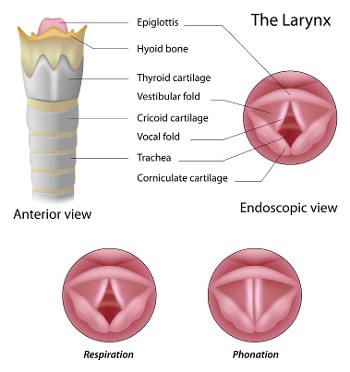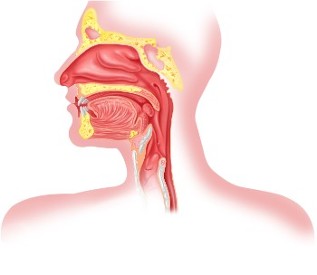 |
Larynx
The larynx or “voice box” sits towards the front of the neck and is the bridge connecting the nose and mouth to the trachea (breathing tube), allowing air to pass thru it as it moves to and from the lungs during breathing. As air moves thru the larynx it passes between the vocal cords to create speech. There are three anatomic parts of the larynx. The supraglottis is the part of the larynx above (superior to) the vocal cords, the glottis refers to the vocal cords themselves, and the subglottis is the part of the larynx below (inferior to) the vocal cords. You can palpate the larynx in the middle of the front of the neck- the “Adam’s apple” is a part of the cartilage that makes up the larynx, and this grows to be more pronounced in men. Cancers or other masses of the larynx can cause difficulty breathing or swallowing, as well as hoarseness or changes in voice quality. In some cases the first sign a patient has a larynx cancer may be a seemingly unrelated mass (lump) in their neck or even persistent ear pain.
|
Pharynx
The pharynx is also broken down into three subsites. The nasopharynx sits behind the nose and is the first part of the aero-digestive tract air enters after filtering thru the nose. After air passes thru the nasopharynx it enters the oropharynx. The oropharynx consists of the soft palate, tonsils, and the base of tongue (back part or root of the tongue) and is the portion of the pharynx sitting directly behind the oral cavity and can be seen when looking thru the mouth. Air moves from the nasopharynx/oropharynx into the larynx during breathing, and during swallowing food moves from the oropharynx to the 3rd part of the pharynx known as the hypopharynx. The hypopharynx sits directly behind the larynx and serves as a funnel to move food into the esophagus (swallowing tube). Similar to cancers of the larynx, cancers of the pharynx can present as difficulty breathing or swallowing, throat or ear pain, a painless neck mass, or have no symptoms at all.
|
 |
If you have, or are suspected to have, a cancer of the larynx or pharynx your doctor will obtain a medical history including your symptoms and risk factors such as tobacco exposure and excessive alcohol consumption. Physical exam will involve carefully feeling your neck for masses and placing a small camera down your nose to look at you larynx and pharynx for evidence of tumors. If there is suspicious lesion noted on exam your doctor may recommend direct laryngoscopy where a patient is taken to the operating room and put under general anesthesia for a short time, allowing a Head & Neck surgeon to look carefully at the larynx and pharynx and to biopsy anything abnormal. A biopsy (taking a piece of tissue) is essential to confirm a diagnosis.
If you are given the diagnosis of cancer of the larynx or pharynx, the term you will likely hear is squamous cell carcinoma Squamous cell carcinoma is a cancer the develops from the squamous cells that make up the lining of the larynx and pharynx. Treatments options for squamous cell carcinomas (cancers) of the larynx or pharynx include radiation therapy, chemotherapy, and/or surgery. The majority of cancers in these locations are treated with radiation with or without chemotherapy. Surgery may be an option instead of radiation for smaller cancers, or as a last resort to treat a very advanced cancer or one that recurs following radiation treatment.